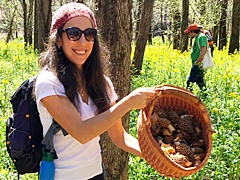
Welcome to Hemlock and Canadice Lakes!
Barns Businesses Cemeteries Churches Clinton & Sullivan Columns Communities Documents Events Time Line Fairs & Festivals Farm & Garden Hiking Homesteads Lake Cottages Lake Scenes Landscapes Library News Articles Old Maps Old Roads & Bridges Organizations People Photo Gallery Podcasts Railroad Reservoir Schools State Forest Veterans Videos
|
“Nature in the Little Finger Lakes” by Angela Cannon Crothers |
|
|
A Wild Harvest Angela Cannon-Crothers June 2018 “All good things are wild and free.” - Henry David Thoreau Maybe it’s because of pictures posted on social media of entirely wildcrafted dinners with morel mushrooms, dandelion greens, venison, and brook trout; but several times this spring I’ve had requests to take someone out foraging. Foraging: to wander or go in search of provisions; to collect forage from; strip of supplies; plunder; to forage the countryside. These days my thoughts wonder regarding how I could satisfy a more feral way of being, quench a native thirst, or simply be more earthy and sustainable by focusing the diet more on wild foods. Could I subsist on tart knotweed pies and jellies, dried juneberry fruit leathers, vinegar dressings of aromatic gill-go-by-the-ground over potherbs like pigweed and lambsquarter weeds? Probably not, but how might changing one’s diet to such humble means possibly reinvent one’s life? Bending to the tasks of gardening and feeling a bit overwhelmed, I wonder if I just allowed the garden to go to weeds what could be harvested there? Based on past weeding efforts I could expect: sorrel leaves, chickweed (which could also be used in salves, too), dandelion greens and heads, pigweed, mustard greens, dock and dandelion roots to roast or tincture, burdock stems for Alex Leto’s Italian cardones or sautéed as is the way Darryl Abraham does, purslane salads, and even mugwort for smudges and dreaming. Who knows what wild harvests one could glean if one did not pull and dig and sweat with the tasks of gardening? Why force what isn’t necessary when so many wild foods are far more nutritious than what we grow, take far more water than what farm vegetables need, and require so little effort to produce for harvest? Euell Gibbons wrote in his introduction to Stalking the Wild Asparagus, “We live in a vastly complex society which has been able to provide us with a multitude of material things, and this is good, but people are beginning to suspect that we have paid a high spiritual price for our plenty.” This was written in 1962. Where are we now? So far this spring what I have gathered and eaten from the wild includes: pesto of garlic mustard, dandelion greens, and wild onion; fiddleheads; morel mushrooms, dandelion fritters; and Japanese knotweed in tincture and tea (Lymes remedy). I have nibbled on all sorts of violet flowers, and have eaten wild turkey cutlets, venison (from last fall), fresh trout (thank you, Lou!), wild mustard greens, marsh marigold, sautéed dandelion leaves, last season’s hawthorn berries, grape leaves, white dead nettle, and probably more I have just forgotten. This month, in June, I will be looking for oyster mushrooms, wild strawberries, purslane, and much more. This is more than sustainable living... more than a survival strategy. This way of knowing, and being, is more than an ancestral knowledge. Foraging feeds more than a body, it also feeds a wilder yearning soul.
|
||
|
Editor’s Note: Angela Cannon Crothers is a naturalist and writer who teaches at Finger Lakes Community College and with The Finger Lakes Museum. Here are some columns that she has written about the Little Finger Lakes. Her columns also appear in the Lake Country Weekender newspaper.
|
||
